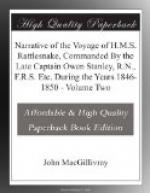The ornaments worn by these savages are very numerous, besides which they are fond of decorating the person with flowers and strong-scented plants. In what may be considered as full dress, with the face and body painted, they are often decked out with large white cowries appended to their waist, elbows and ankles, together with streamers of pandanus leaf. Among many kinds of bracelets or armlets the most common is a broad woven one of grass, fitting very tightly on the upper arm. There are others of shell—one solid, formed by grinding down a large shell (Trochus niloticus) so as to obtain a well polished transverse section, and another in two or three pieces tied together, making a round smooth ring; of the former of these five or six are sometimes worn on one arm. But the most curious bracelet, and by no means an uncommon one, is that made of a human lower jaw with one or more collar bones closing the upper side crossing from one angle to the other. Whether these are the jaws of former friends or enemies we had no means of ascertaining; no great value appeared to be attached to them; and it was observed, as a curious circumstance, that none of these jaws had the teeth discoloured by the practice of betel chewing.
We procured various sorts of necklaces—strings of shells, black seeds, and dogs’ teeth. As the canine teeth alone are used in making one of the last description, the number of dogs required to complete a single necklace must be considerable. A round thin, concave piece of shell (Melo ethiopica) with a central black portion, is often worn suspended by a string round the neck, and similar ornaments, but much smaller, are attached to the hips and elbows. The long nose-stick of shell is only occasionally worn, although everyone, of either sex, has the septum of the nose pierced for its reception—an operation most likely performed during infancy, as I once saw that it had been done to a child about a year old.
Nearly all the men carried in their hair a comb projecting in front or on one side. This article is usually made of wood, but occasionally of tortoise-shell, a foot in length, thin, flat, and narrow, with about six very long, slightly diverging, needle-shaped teeth, but it admits of much variety of size and shape, and frequently has various ornaments attached to it. The spatula used by betel chewers to introduce the lime to the mouth, although often made of tortoise-shell and resembling that figured above, is more commonly made of coconut-wood, with a massive handle, deeply divided by a slit, and when struck upon the knee it is made to produce a loud clicking noise like that of castanets.




